You might say 2015 hasn’t been the most exciting year for graphics cards, though in many ways it was more eventful than 2014. The only big highlight last year was the arrival high-end Maxwell GPUs in the form of the GeForce GTX 980 and 970. Then this year Maxwell did what many thought was impossible: becoming considerably faster.
AU Editor’s Note: This story has been updated with Australian pricing where possible. Price estimations were pulled from PCPartPicker, and averaged across any card’s particular price range. While the original story was based on US prices, we think the conclusions made of performance between competing cards is still relevant and interesting. — Cam
Last year’s GTX 980 featured 2048 CUDA cores, which now looks underwhelming put against the Titan X’s whopping 3072 CUDA cores, a nice 50 per cent bump for the architecture. Nvidia also went the other way, releasing the circa-$250 GTX 950 which sports just 768 CUDA cores.
All told, Nvidia released four new GPUs in 2015, while AMD delivered eight cards if you’re willing to be loose with the definition of “new” and three if you’re not, namely the Radeon R9 Fury X, Fury and Nano.
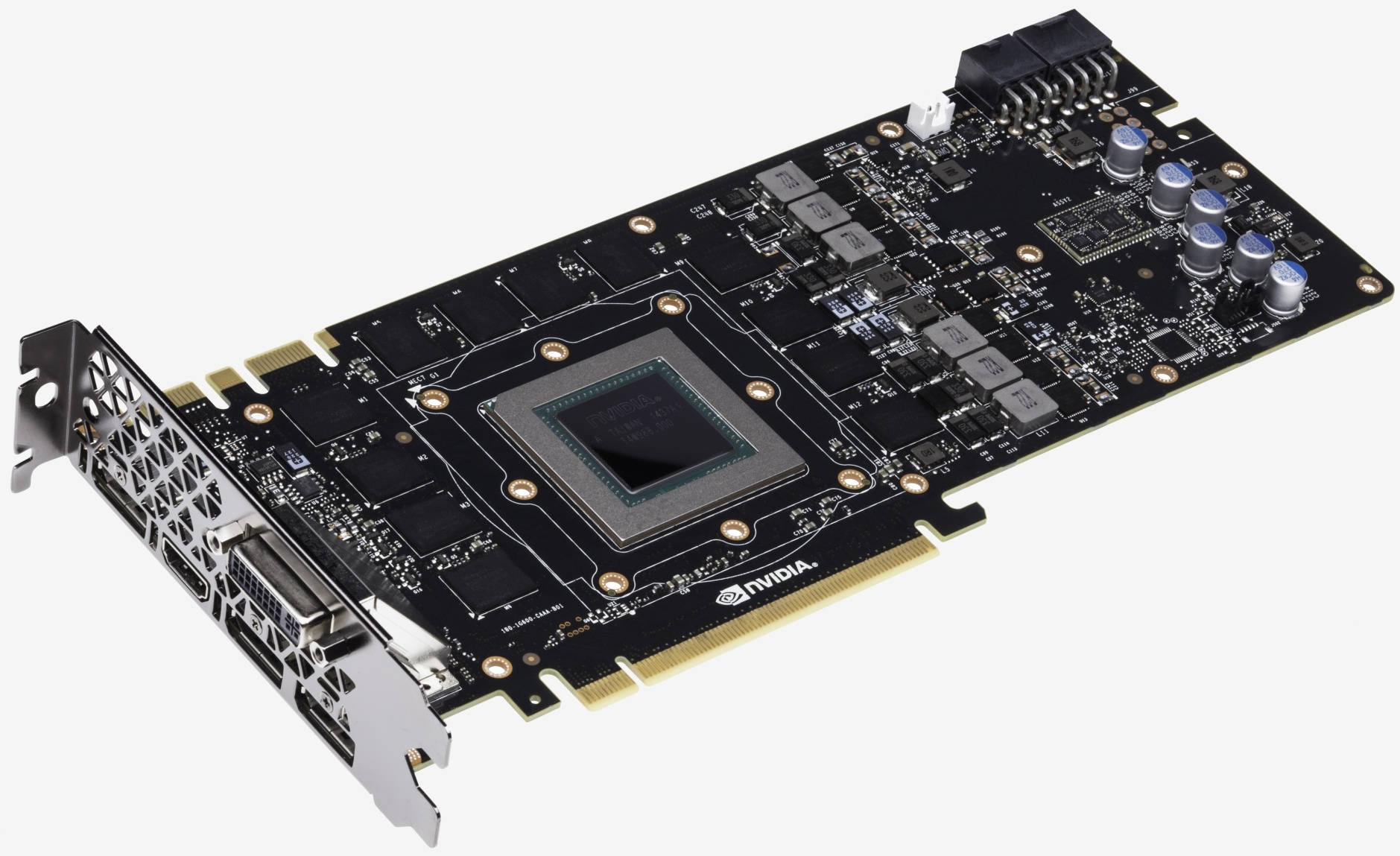
Some of you are probably shouting that the 390X and 390 are new as well. Yes, the Radeon R9 390X and 390 received double the VRAM, but they are essentially the same GCN 1.1 GPUs — 290X and 290, respectively. Thus far, the larger 8GB memory buffer has proven to be of little benefit, so we prefer the cheaper 290s anyway.
At this point, it looks like AMD and Nvidia have finally squeezed the most out of the 28nm design process. Before moving on, AMD will release a dual-GPU version of the Fury X which should become the Fury X2. Nvidia could also return fire with a dual-GPU monster of its own.
Something we haven’t seen a lot of this year has been price cuts. AMD was forced into aggressive discounts last year to compete, but this year the company has been competitive at the upper end of the high-performance GPU market and has therefore felt less pressure to reduce prices.
The key battles are currently being played out between the GTX 750 Ti and R7 360 at similar prices of around $160, the R7 370 and GTX 950 at prices of approximately $230 and $250, the R9 380 and GTX 960 at $280 and $300 respectively, the R9 390 and GTX 970 at $500 and $520, the R9 390X and GTX 980 at $620 and $800, and finally the R9 Fury X and GTX 980 Ti at $1100 and $1200. By the end of this article we should have figured out what are the best buys at every price point.
AU Editor’s Note: As you can see, in Australia, we pay a premium for cards based on Nvidia’s GeForce GTX graphics chipsets versus AMD’s Radeon cores. (This data comes from PCPartPicker.) In the US, the cards mentioned in pairs above are roughly equal in price, making a comparison between each two relevant. In Australia, the argument is whether it’s worth paying more for an Nvidia card, based on the benchmark results below. — Cam
Test System Specs
- Intel Core i7-5960X (3.00GHz)
- x4 4GB Kingston Predator DDR4-2400 (CAS 12-13-13-24)
- Asrock X99 Extreme6 (Intel X99)
- Silverstone Strider Series (700w)
- Crucial MX200 1TB (SATA 6Gb/s)
- GeForce GTX 750 Ti (2048MB)
- GeForce GTX 760 (2048MB)
- GeForce GTX 950 (2048MB)
- GeForce GTX 960 (2048MB)
- GeForce GTX 970 (4096MB)
- GeForce GTX 980 (4096MB)
- GeForce GTX 980 Ti (6144MB)
- GeForce Titan X (12288MB)
- Radeon R7 265 (2048MB)
- Radeon R7 360 (2048MB)
- Radeon R7 370 (2048MB)
- Radeon R9 270 (2048MB)
- Radeon R9 285 (2048MB)
- Radeon R9 380 (2048MB)
- Radeon R9 390 (8192MB)
- Radeon R9 390X (8192MB)
- Radeon R9 Fury (4096MB)
- Radeon R9 Fury X (4096MB)
- Microsoft Windows 10 Pro 64-bit
- Nvidia GeForce 358.50
- AMD Catalyst 15.7.1
Benchmarks: Battlefield 4, Thief
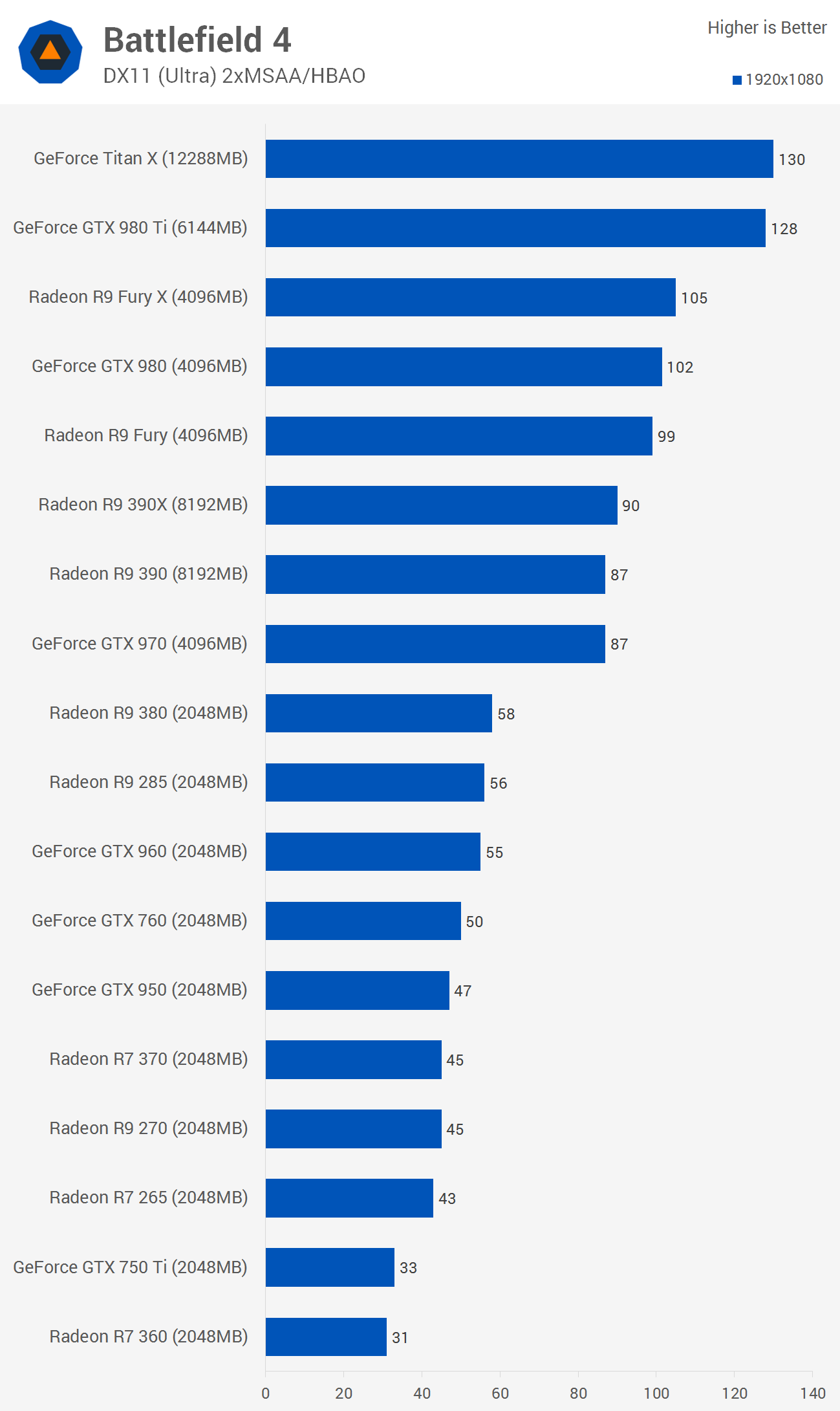
Starting with the budget cards we see that the R7 360 was 6 per cent slower than the GTX 750 Ti at 1080p with an average of just 31fps. The R7 370 also lost out to the GTX 950 as it was 4 per cent slower with an average of 45fps.
AMD got its first win in the $230-$300 battle as the R9 380 was 5 per cent faster than the GTX 960 with an average of 58fps. The R9 390 vs. GTX 970 battle ends in a tie as both graphics cards averaged a very playable 87fps at 1080p.
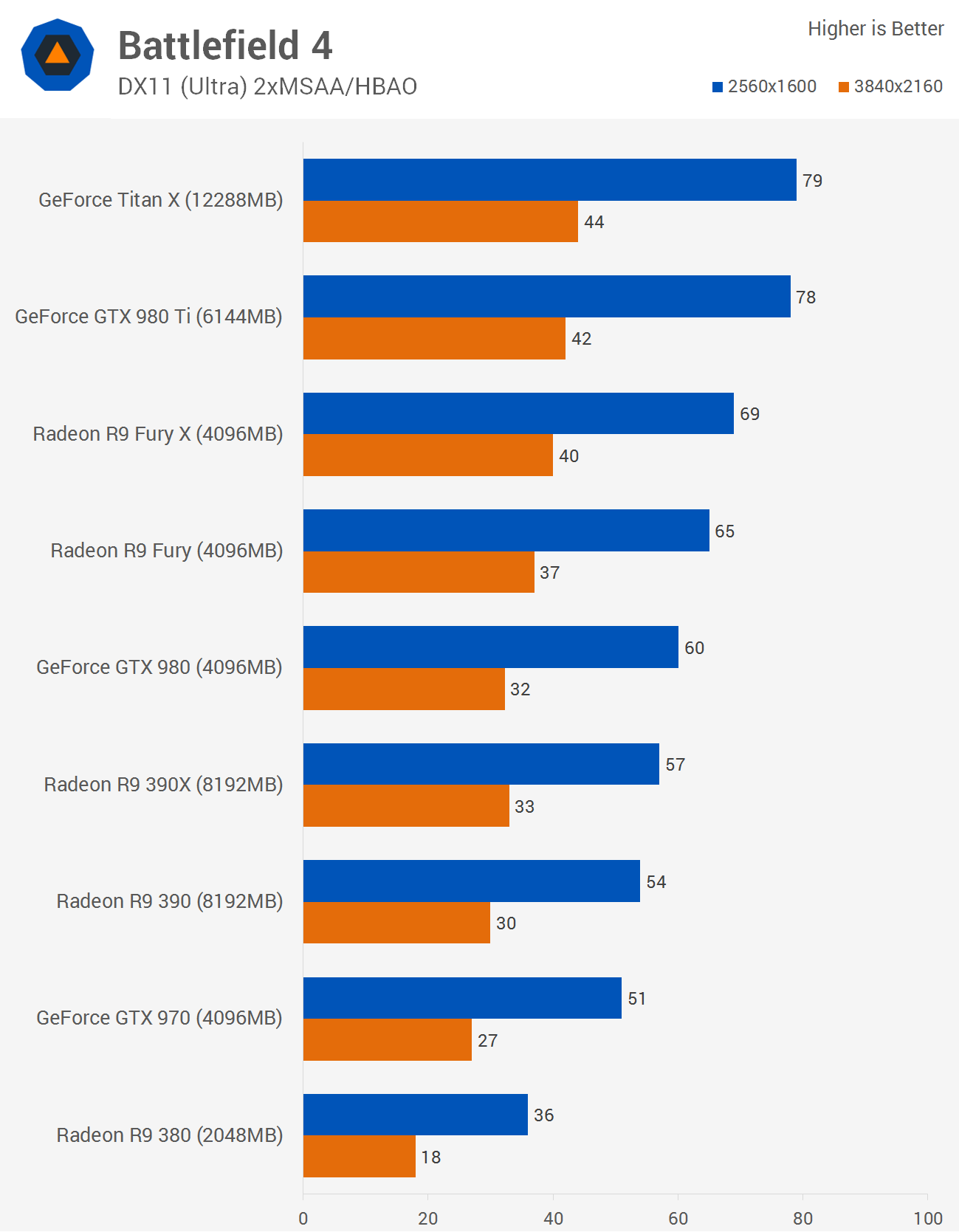
Moving to 1600p for the $620-$800 battles, the R9 390X was 5 per cent slower than the GTX 980 (though it’s cheaper as well), the Fury X suffered a 12 per cent blow against the GTX 980 Ti which allowed for an average of 78fps, and the Fury X was limited to 69fps.
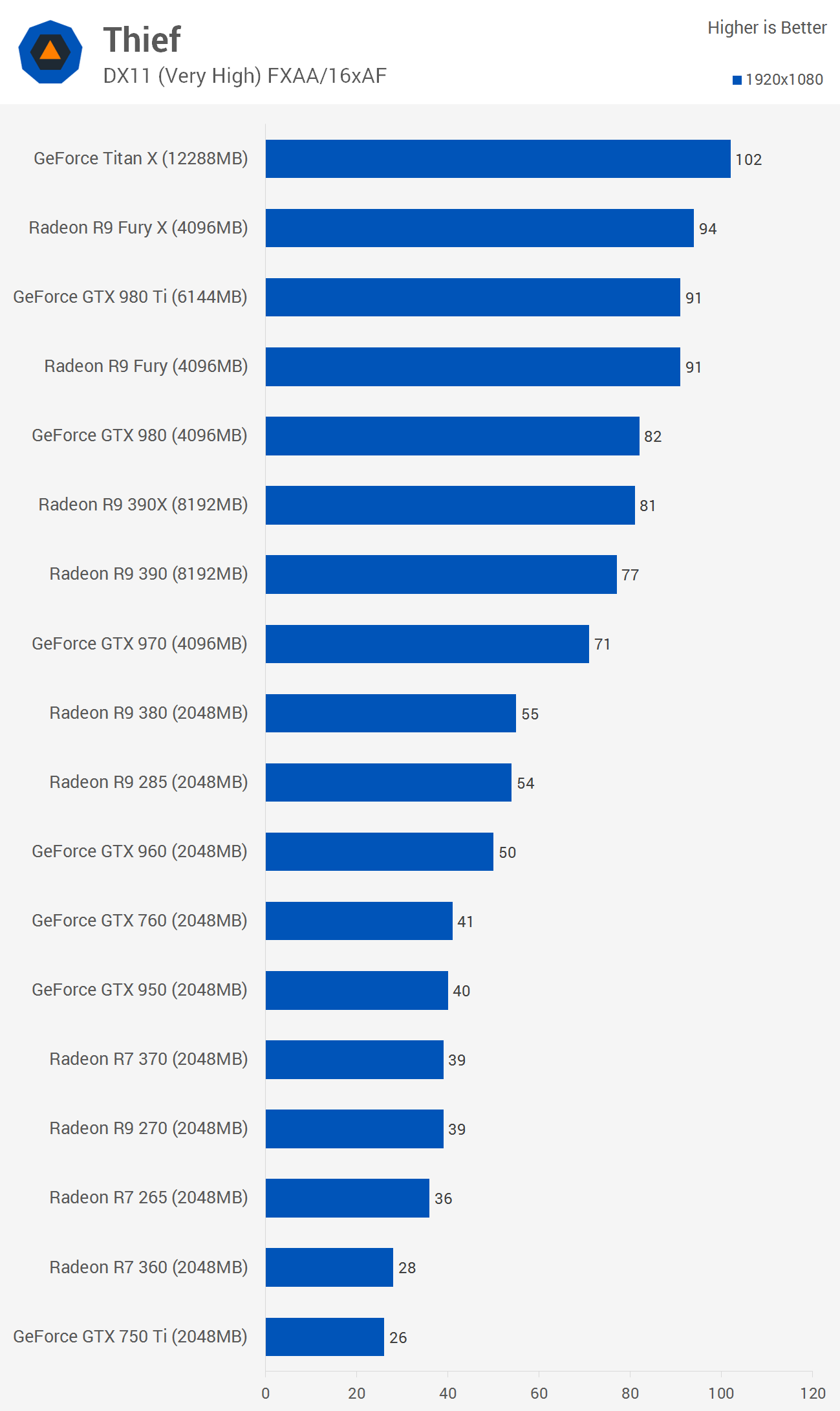
The R7 360 took charge in Thief at 1080p as it was 8 per cent faster than the GTX 750 Ti with an average of just 28fps. The R7 370 was still slower than the GTX 950 though this time by just a single frame which equated to a 3 per cent performance margin. The R9 380 pulled further ahead of the GTX 960 with an average of 55fps making it 10 per cent faster. The R9 390 was also 8 per cent faster than the GTX 970 and it managed an average of 77fps.
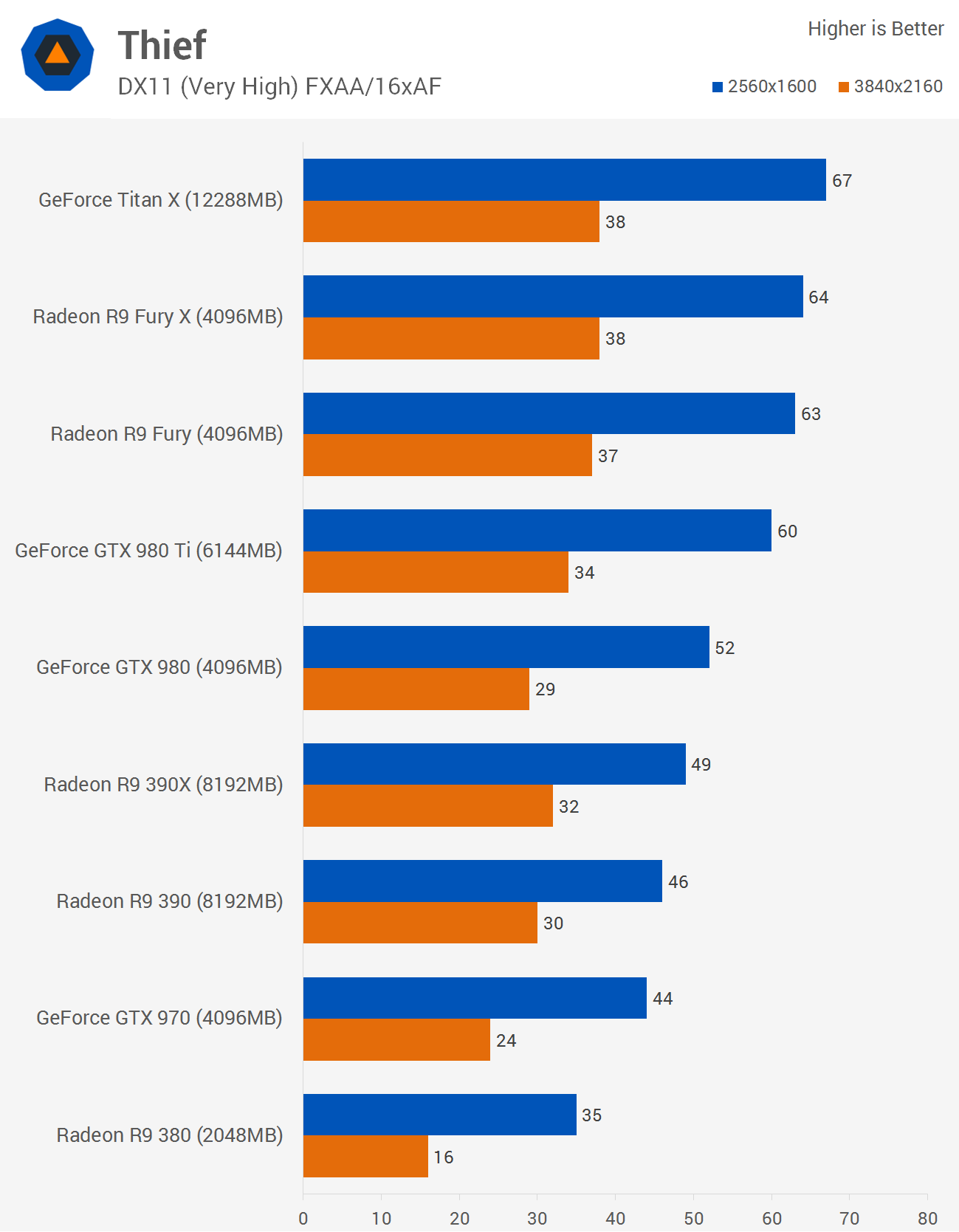
Jumping up to 1600p we see that the R9 390X was 6 per cent slower than the GTX 980 while the GTX 980 Ti was 6 per cent slower than the Fury X.
Benchmarks: Watch Dogs, Far Cry 4
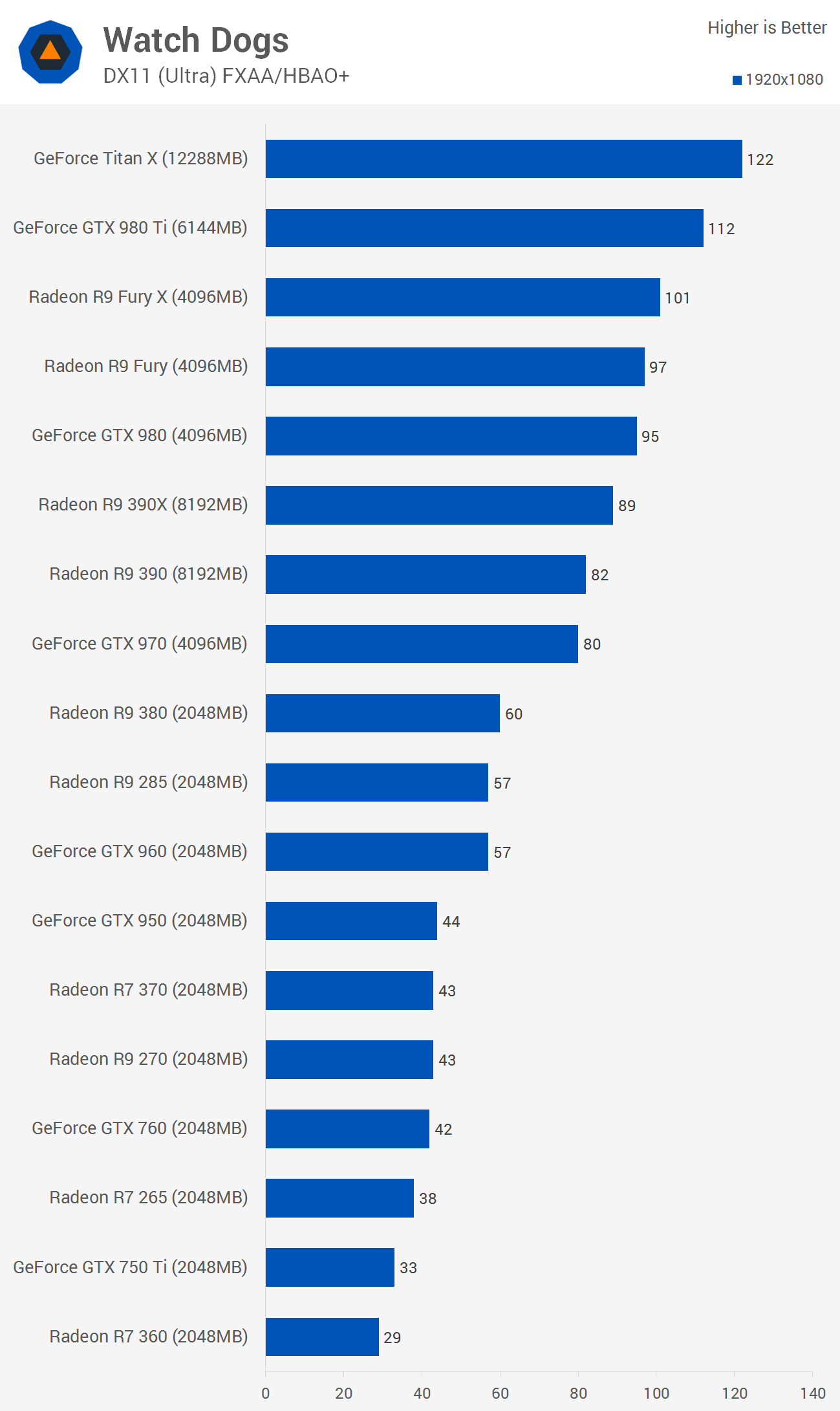
The R7 360 really struggled in Watch Dogs and with an average of just 29fps it was 12 per cent slower than the GTX 750 Ti. The R7 370 performed better though it was still 2 per cent slower than the GTX 950 (just a 1fps difference here).
The R9 380 was again able to outpace the GTX 960 by a small 5 per cent margin at 1080p. The R9 390 was only 3 per cent faster than the GTX 970 which worked out to be a 2fps advantage.
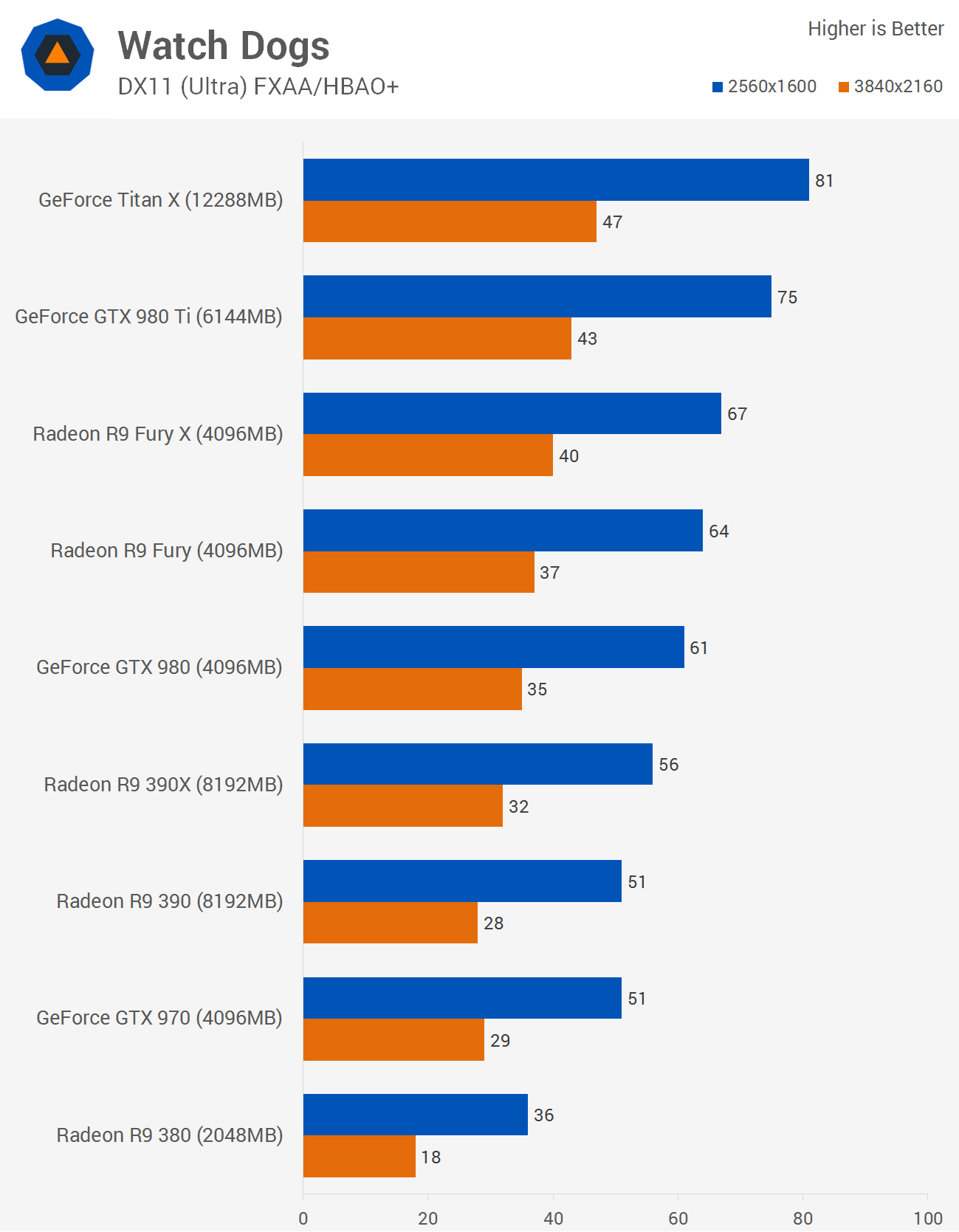
Increasing the resolution to 2560×1600 we find that the R9 390X was 8 per cent slower than the GTX 980, while the Fury X was 11 per cent slower than the GTX 980 Ti.
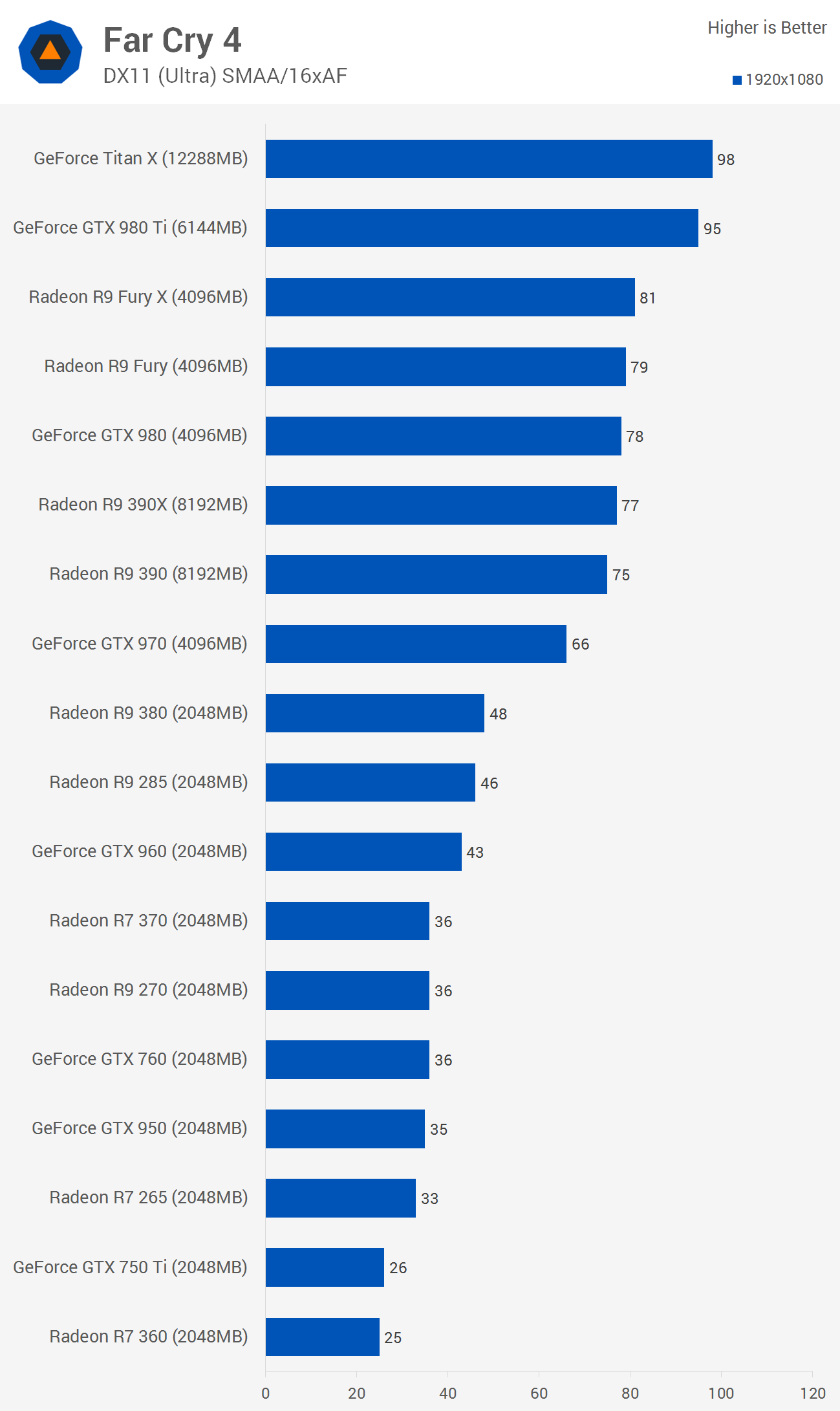
AMD is expected to have an advantage in Far Cry 4, though this wasn’t true for the R7 360, which was still 4 per cent slower than the GTX 750 Ti at 1080p with an average of just 25fps. Despite that the R7 370 was 3 per cent faster than the GTX 950, which equated to just a single frame per second.
The R9 380 continued its dominance over the GTX 960 with a 12 per cent win in Far Cry, where it averaged 48fps opposed to 43fps. The R9 390 enjoyed its biggest win yet with 75fps on average, 14 per cent faster than the GTX 970.
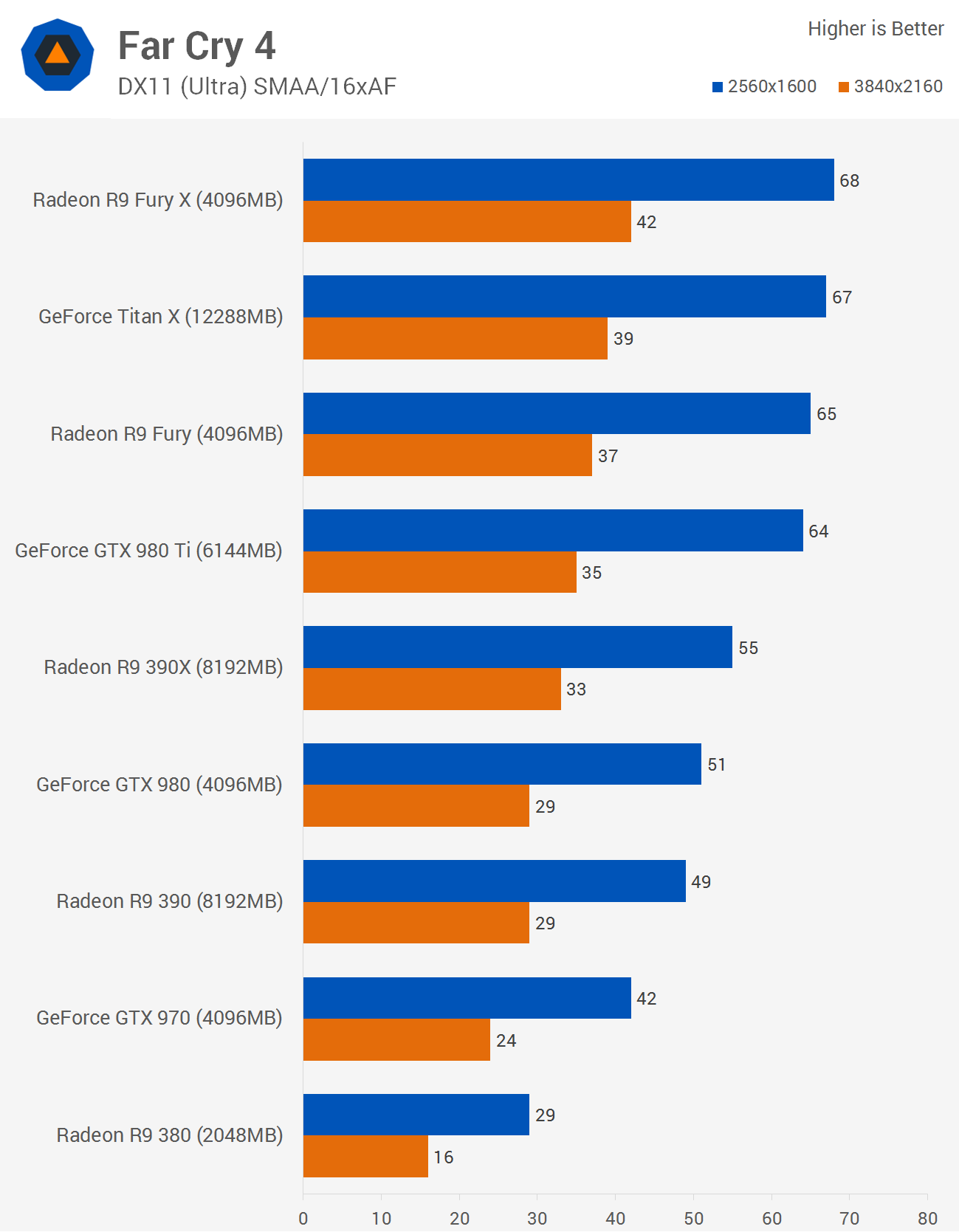
For the first time the R9 390X was faster than the GTX 980 at 1600p with an average of 55fps for an 8 per cent lead. The Fury X also outpaced the GTX 980 Ti, winning by a 6 per cent margin.
Benchmarks: Civilisation, Total War Attila
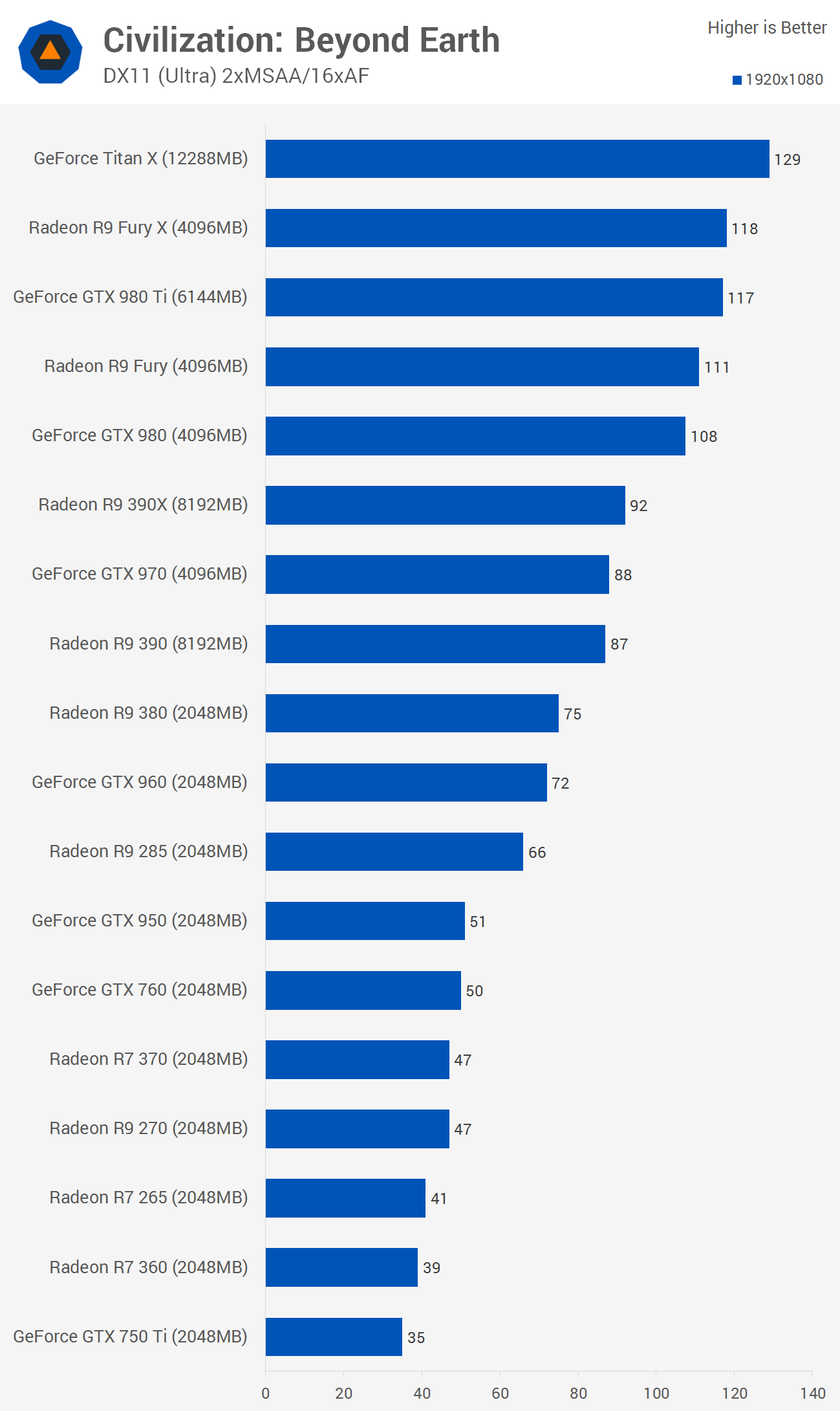
The R7 360 was good for 39fps at 1080p in Civilisation: Beyond Earth, 11 per cent faster than the GTX 750 Ti. However, the R7 370 didn’t fare quite as well falling short of the GTX 950’s 51fps by an 8 per cent margin. The R9 380 once again took control over the GTX 960 as it was 4 per cent faster. Finally, the R9 390 was just 1 per cent slower than the GTX 970.
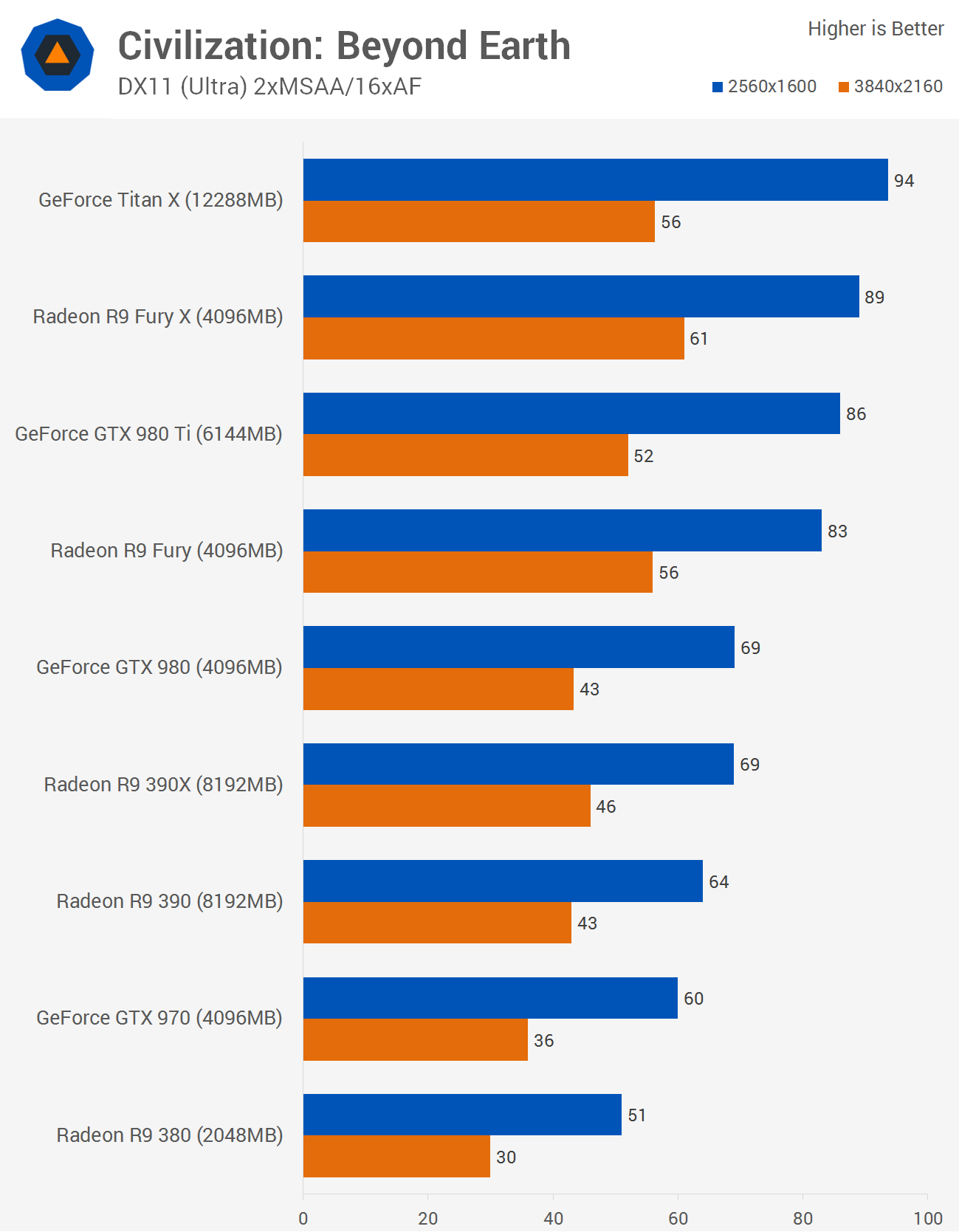
Increasing to 1600p we found the R9 390X and GTX 980 delivering the exact same performance with an average of 69fps each. The Fury X was also 3 per cent faster than the GTX 980 Ti, though with 89fps it was just 3fps faster.
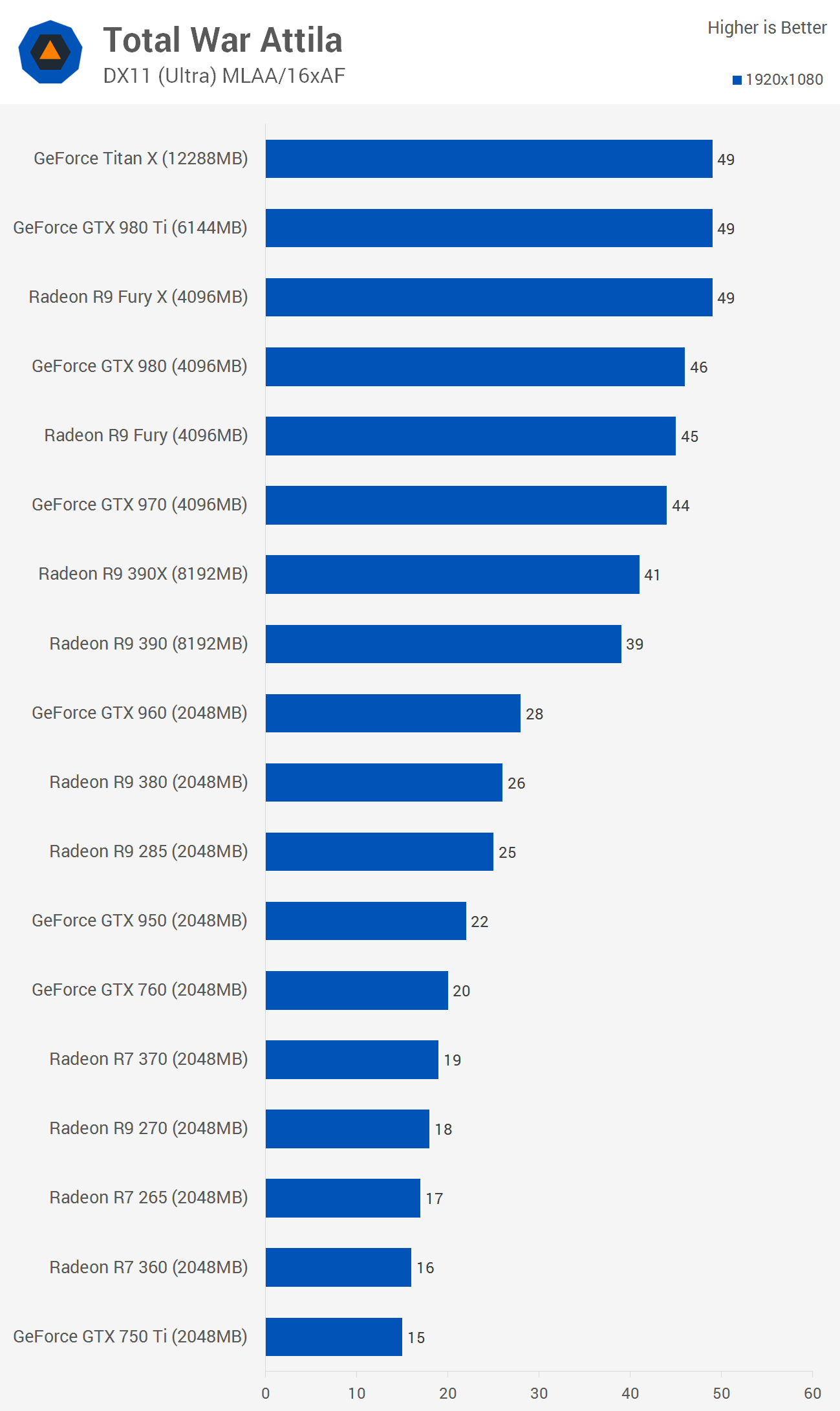
The 1080p resolution proved too much for the sub-$200 GPUs and while the R7 360 was 7 per cent faster than the GTX 750 Ti, it only managed an average of 16fps. The R7 370 was crushed by the GTX 950, delivering 14 per cent less performance for an average of just 19fps. That said, the GTX 950 wasn’t exactly smooth with 22fps.
Moving up to the R9 380 vs. GTX 960 battle we are on the edge of playable performance and for the first time the R9 380 is slower than the GTX 960 — 7 per cent slower, in fact. The R9 390 was also 11 per cent slower than the GTX 970 which managed an impressive 44fps.
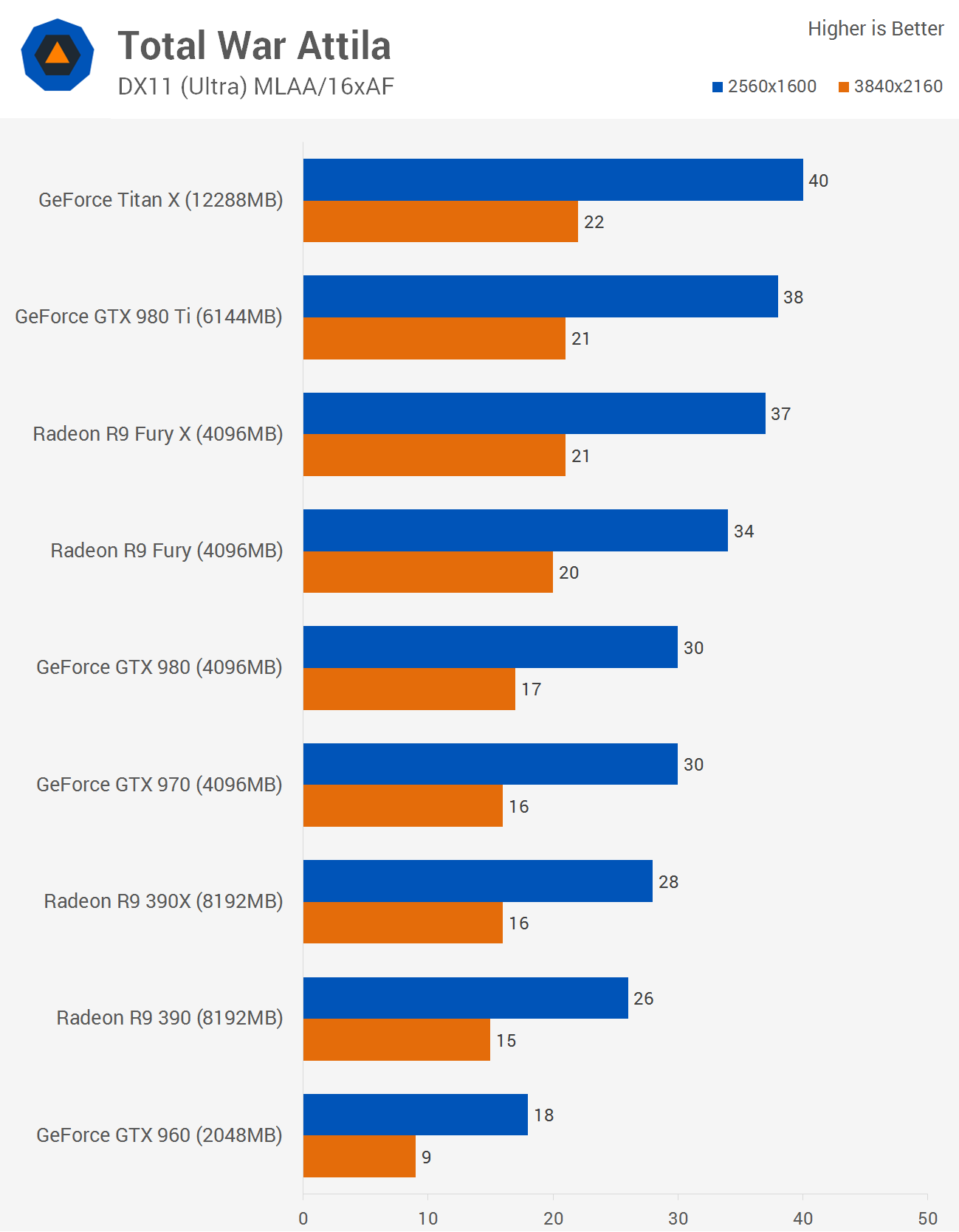
Playing Total War: Attila at 1600p using the maximum in-game setting puts a huge load on the system, the result being that high-end graphics cards such as the R9 390X average just 28fps and this meant it was 7 per cent slower than the GTX 980 which offered just 30fps.
The R9 Fury X managed 37fps, just 3 per cent slower than the GTX 980 Ti’s 38fps average.
Read More:
|
Republished with permission from:

Steven Walton is a writer at TechSpot. TechSpot is a computer technology publication serving PC enthusiasts, gamers and IT pros since 1998.
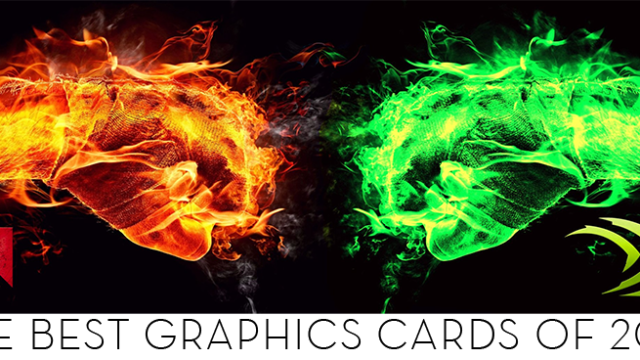
Comments
51 responses to “Graphics Card Battle 2015: Nvidia Versus AMD At Every Price Point”
Its way to expensive to game at 60fps on ultra higher than 1080p. I got a 1440 monitor over 2 years ago and it still would cost over $500 for 60fps 🙁
I have a 4gb gtx960, and I play a lot of my stuff at 2160p at over 60fps Depends a lot on the engine the game is built using.
I would like to trust you but my SLI 670 which is in between GTX 970 and GTX 980 can’t even 60fps on everything so I doubt you can be over 60fps at 2160p.
Well, I can certainly provide proof in the form of screenshots. I run games like Reflex at 3840×2160, and I get 70-100 fps depending on the level. Might not be max settings for everything in that game, but close. Plenty of games I play I get good fps though at that res. Some games (like Dirt Rally) I have to run at 2560×1440 to get decent fps, but most games seem to cope fairly well at 2160 for me. I’m only running an i7 920 and 12gb of ddr3 too (mind you, it’s triple channel)
Oh you mean old games and non graphically intensive games. Well I can run bioshock infinite ultra at 4k 60fps too. Not possible to run any new game at 4k 60fps.
I’ve managed to get decent frame rates out of UE4 games at 4k. Some UT levels I can get over 100 fps in sections, and don’t really see it drop below 70. Sure not all my settings are maxed, but I wouldn’t expect to be able to run it like that given I only have a 960. Some game types work better than others (like fps/rts), but I’ve got other modern games running at 4k 60fps too. Sure not all of them, but I know that I’m pushing the limits of my pc hardware already, so not surprising. Reflex is still new though, and while I don’t know exactly what engine it’s built on, not even out of early access yet, so can’t be too old. It really does depend a lot on the engine and the drivers being tweaked for the game (hence why they often release new drivers when games come out.)
Sure, to be consistent in running EVERYTHING at 4k 60fps will cost you a bunch of $, but my point was more that it is actually possible with a sub $500 GPU investment 🙂
Yeah I barely got 60fps at 4k on Witcher 3 (though easily solid on MGSV) on two 980ti so yeah, a 960 aint do 60fps on anything over 1080 on a new game…….
After dabbles with 4K, I decided that 1440p 60fps was my sweet spot. I’ve got a R9 390X and an Asus MG279Q with Freesync, and everything looks quite nice thank you very much.
Hey guys, so I added in a whole bunch of Australian pricing for all these cards — and you can very clearly see that AMD cards are trading punches with Nvidia cards $100-$200 above their weight. We’re in a very different situation to the US where those cards are equal in price.
But plenty of people still choose Nvidia — including me, in my last build — which I think is super interesting. Discuss.
Main reason I buy nvidia is due to a lot of the tools I use being built around cuda or other functions simply not available on amd.
I’ve heard there’s a way to run cuda stuff on AMD now, but not all stuff afaik.
Brand loyalty mostly and the fact that a lot of games run better on nvidia cards under DX11 (and also, Gameworks). I expect things to turn around for AMD once DX 12 start to go mainstream.
I know I am getting a R9 390 for my next build.
Yep, I’m actually on a MSI 390X 8GB at the moment! Loving how powerful it is, and I’ve always preferred Freesync to G-SYNC. Can’t wait for more DX12 applications to come out.
I only went with a GTX970 cause there wasn’t an AMD competitor at time of release.. and even now it seems to be mostly competitive with the 390X which is ~$100 more expensive.
I’d consider AMD next time around because Freesync monitors seem to be a great deal cheaper with more variety available than G sync.
I think plenty of people still choose Nvidia despite the AMD’s being cheaper is that a lot of people still see AMD as the more budget option, and they want a premium product with a higher perceived build quality. Also, Nvidia have a much much better track record for reliability. I’m sure some individual experiences will vary but for the most part Radeon cards tend to be more flakey than GeForce cards.
My first card was an AMD and that blew out fairly quickly though, had a few Nvidia cards after that no problem and now have another AMD that was handed to me but the fan is incredibly loud (6970). My personal experience is that Nvidia are of a better build quality
Btw, the R9 380 is around $290 minimum, not $230
Equating build quality to originator is a bit of a fallacy. Everything but the GPU itself is made by the manufacturer (gigabyte, asus, sapphire, evga, zotac, etc), so it really sounds like you cheaped out with the manufacturer when you went amd.
The first card (from my very scratchy memory) was a Sapphire card while the Nvidia cards were all Evga which I got because they were budget. It’s been a while since I checked what build my 6970 is but I think it’s Gigabyte. I’m debating though whether it’s worth changing the fan on it for a quieter model from Arctic Cooling or just upgrade to a new card. Tbh though, my whole pc is in dire needs of upgrading 🙁
I’m still running my HIS 6970 from when I purchased it new a few years ago. It’s beginning to struggle and the temps are through the roof these days.
When the fan spins up I’m afraid it’s going to rattle the case apart!
My last AMD card (4870X2) fried my PC and a repair guys when he was troubleshooting.
Nvidia never has done that 3 of em…. So went back (GTX670)
This is the big one. Locally, we would care about bucks more than the bangs. I had my heart set on an Nvidia card after owning an AMD one, but this article does more to confuse me than it does enlighten (that’s on me, not you).
My apologies if I missed it, but did you do a write-up for that build? I would dearly love a ‘Kotaku pimps my ride’ article or something.
Nvidia drivers have caused me a lot less issues over the years, specially in the crossfire/SLI department. Remember the AMD crossfire micro stutter issue?
I’ve generally been with AMD due to better bang for buck, but currently I’m with Nvidia.
I was going to buy a GTX970 as at the time I’d say they were arguably best value card out there, good performance and good price. But instead I purchased a second hand GTX780ti and a waterblock for a really good price.
You make a valid point with the whole US/AU pricing – and I think a lot of people read up on forums etc and read opinions based in a different context to ours (US opinions) without taking into consideration that our pricing isn’t the same – and it rubs off down here.
I still can’t decide between a R9 390 and a 970. Is the VRAM worth it? How do they compare when it comes to HBAO+, Hairworks or AC4’s smoke effects? I’m assuming the 390 can’t use any of these
970 has a huge issue where it bottlenecks when it hits the 3.5gb buffer, and has to start using the painfully slow 64 bit bus. Yes, you can’t use hairworks on the 390 or the smoke from AC4, but the smoke in AC4 is awful with that particle effect (you can’t see anything), and hairworks murders fps in Witcher 3.
My experience has also been that AMD cards seem to hold their own for longer than the Nvidia cards, it feels like I buy an Nvidia card then as soon as the next series gets released they stop caring about optimizing their drivers for the newer games.
Also I think the VRAM will be important in future titles.
Faced with this choice for me it was the 390. It seems to creep out ahead of the 970 is most tests but given it’s potential for better DX12 performance and 8GB vs. 3.5GB of memory it was the 390 that one for better future proofing.
Glad my titan X can basically pull off most scenario’s 60fps
bugger SLI single cards where its at
Use Amazon if you want to save some serious money on graphics cards in Australia, depending on the (80ti model you can save upwards of 300+ dollars on the premium models and get them around a grand delivered.
Do you get the local warranty with that though? Or do you have to send it back to Amazon? I’ve always wondered because it does seem like a good deal but if there’s no local warranty then I would probably still pay the premium.
This is the big issue. You don’t get local support if you purchase from overseas. You have to return to the place of purchase, but this may hopefully change with the announcement that places like New Egg etc. will now ship to aus through local suppliers.
Yeah this was my problem with it. Most of the time there’s no issue but when you get a lemon you want to be able to get it sorted locally. To me that’s worth 200 to 300 dollars when you are already paying a grand.
If you buy from EVGA they are pretty good with worldwide warranty.
Does Evga have an office in Australia? I didn’t think they did so where would you return the product?
I think they give you a shipping label and you post it to taiwan.
Often times you will have a faster turnaround than dealing with the place you bought it from considering when you return it to them they just ship it back to taiwan anyway.
This is good to know, thanks for the info!
Yep have to send it back to them, but ask yourself how many cards have you had issues with brand new out of the box?, And if you are so worried about being cardless incase something went wrong and you had to send it back spend a portion of that 300+ bucks you just saved on a budget card to holdd you over:P
Hmm, it looks like R9 390 outperforms the GTX 970 by around 2fps in most titles. You can pick up a GTX 970 Windforce atm for $479 but the R9 390 costs $550+ from the places I’ve looked. It still looks like GTX 970 is the best value for money? Or am I looking at the wrong stores?
Just had a quick look on pc case gear and they have most of their 390s listed the 499. Personally for 1080p I would still go the 970 unless you want to game at 1440p then the extra 4gb frame buffer will be handy.
The 970 from PCCG would be better in the short term but the 390 would be better in the long term.
The price difference on PCCG is about 30 dollars if you buy the cheapest 970 but if you want one with a 3 year warranty (Which you should) the price difference is only 20 dollars.
3 year warranty is beyond the typical upgrade cycle for most people with graphics cards, which is 2 years. It’s a good idea if you’re the infrequent updater type but doing every second generation tends to sit you on the 2 year mark and seems to be fairly popular.
That said, the difference is only $10 between the Galax (2 year) and the ASUS (3 year) 970 on PCCG at the moment and ASUS is a much more reputable brand. The ASUS 970 is cheaper than the Gigabyte R9 390 for the same warranty and comparable performance, so it comes down to secondary things in the end:
970 advantages:
– Much better power efficiency
– Better stable overclock potential
– Native Gameworks support
390 advantages:
– More memory
– No high range performance hit (though this isn’t as common as one might think on the 970)
– FreeSync support
Anecdotally, Nvidia drivers tend to be a lot better than AMD drivers and in Steam-oriented survey data people typically have fewer compatibility issues with Nvidia cards, but ultimately it comes down to minor preferences between those two cards.
Just got the Acer 4k gsync monitor due to the 100 off special that pccasegear has going. I’ve got two 980tis powering this beast and all I can say is wow! 4k gaming at 60fps is off the hook! I would have to say that last year my favourite card was the 390. It was 100 cheaper than the 780 and pretty much kept up with it. I had the Asus direct Cu ii one and the temps were always in check. It was my first amd card and I was very impressed. Then I moved onto the 295×2 and that when I lost all love for amd. Crossfire support was terrible I would have to wait up to 2 months for a profile and even then you couldn’t turn things like aa on. My advice is amd is the better deal for single cards (unless you are looking at the fury x and 980ti) and nvidia is much better in dual gpu set ups.
Do you grow money on trees?
Haha I don’t really have any other interests except gaming and I usually get money back for my old hardware so that goes towards the new gear. I figure this set up will last maybe 4 to 5 yearso so spread out it equates to a couple of nights out on the piss. Anyway this is what a tell myself haha
Funny. I’ve been running the 295×2 for a while now on a triple monitor setup. It’s taken everything I’ve thrown at it and I’ve never had issues with the Crossfire support.
I am waiting until next year to see what the next generation of nVidia bring to the table before I decide on my next card. Doesn’t seem to be a lot of information about Pascal yet though, unless I am missing something.
All we know is that the performance gains next year are going to be enormous.
If people can wait till next year to get a graphics card then thats the best bet.
No 295×2?
My gigabyte 980Ti sc was 1095 from cpl. At the time (june) it was the most expensive 980 Ti cpl sold.
Am i the only person who wants an R9 Nano purely because it’s so damn cute?
still got a HD5850 here with a Phenom II 965 Black Edition and 12GB ddr3 RAM, im just getting to the stage now where my 1GB video card cant run some games at all because they need 2GB minimum: eg Battle Front Beta :'(
My friends laugh when i show them what my GTA V looks like while theyre all using GTX 9 series cards.
not sure which way ill go when i finally get to upgrade. i really would love to go for the 295×2 but the power consumption is way too high. i love the idea of the GTX980ti but the cost is crazy and really wanna see how both red and green go int he next 6 months with new cards and DX12 integration on games and HBM RAM.
unfortunately its going to have to be a waiting game for me before i can get upgrades.
who knows, maybe game streaming by NVIDIA might be a big thing over the next year meaning end users dont need to have the grunty hardware.
definitely an interesting time ahead in the next 6 to 12 months.
I’m going to go for a Radeon R9 290 from Sapphire. I found one going for $340.